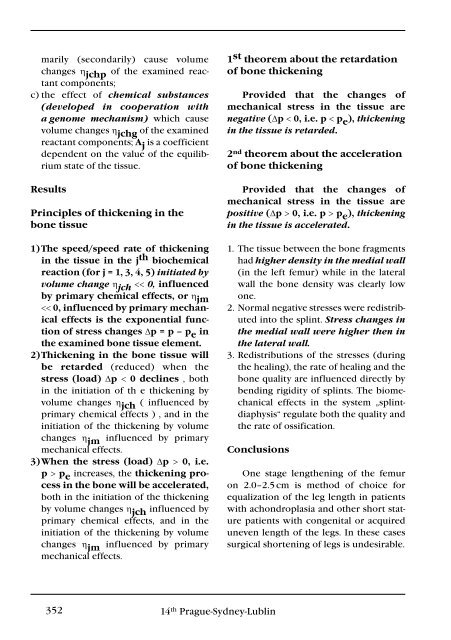3+4+Supplementum/2012 - Společnost pro pojivové tkáně
3+4+Supplementum/2012 - Společnost pro pojivové tkáně
3+4+Supplementum/2012 - Společnost pro pojivové tkáně
- TAGS
- www.pojivo.cz
You also want an ePaper? Increase the reach of your titles
YUMPU automatically turns print PDFs into web optimized ePapers that Google loves.
marily (secondarily) cause volume<br />
changes η jchp of the examined reactant<br />
components;<br />
c) the effect of chemical substances<br />
(developed in cooperation with<br />
a genome mechanism) which cause<br />
volume changes η jchg of the examined<br />
reactant components; a j is a coefficient<br />
dependent on the value of the equilibrium<br />
state of the tissue.<br />
Results<br />
Principles of thickening in the<br />
bone tissue<br />
1) The speed/speed rate of thickening<br />
in the tissue in the j th biochemical<br />
reaction (for j = 1, 3, 4, 5) initiated by<br />
volume change η jch p e increases, the thickening <strong>pro</strong>cess<br />
in the bone will be accelerated,<br />
both in the initiation of the thickening<br />
by volume changes η jch influenced by<br />
primary chemical effects, and in the<br />
initiation of the thickening by volume<br />
changes η jm influenced by primary<br />
mechanical effects.<br />
352 14 th Prague-Sydney-Lublin<br />
1 st theorem about the retardation<br />
of bone thickening<br />
Provided that the changes of<br />
mechanical stress in the tissue are<br />
negative (∆p < 0, i.e. p < p e ), thickening<br />
in the tissue is retarded.<br />
2 nd theorem about the acceleration<br />
of bone thickening<br />
Provided that the changes of<br />
mechanical stress in the tissue are<br />
positive (∆p > 0, i.e. p > p e ), thickening<br />
in the tissue is accelerated.<br />
1. The tissue between the bone fragments<br />
had higher density in the medial wall<br />
(in the left femur) while in the lateral<br />
wall the bone density was clearly low<br />
one.<br />
2. Normal negative stresses were redistributed<br />
into the splint. Stress changes in<br />
the medial wall were higher then in<br />
the lateral wall.<br />
3. Redistributions of the stresses (during<br />
the healing), the rate of healing and the<br />
bone quality are influenced directly by<br />
bending rigidity of splints. The biomechanical<br />
effects in the system „splintdiaphysis“<br />
regulate both the quality and<br />
the rate of ossification.<br />
Conclusions<br />
One stage lengthening of the femur<br />
on 2.0–2.5 cm is method of choice for<br />
equalization of the leg length in patients<br />
with achondroplasia and other short stature<br />
patients with congenital or acquired<br />
uneven length of the legs. In these cases<br />
surgical shortening of legs is undesirable.

















